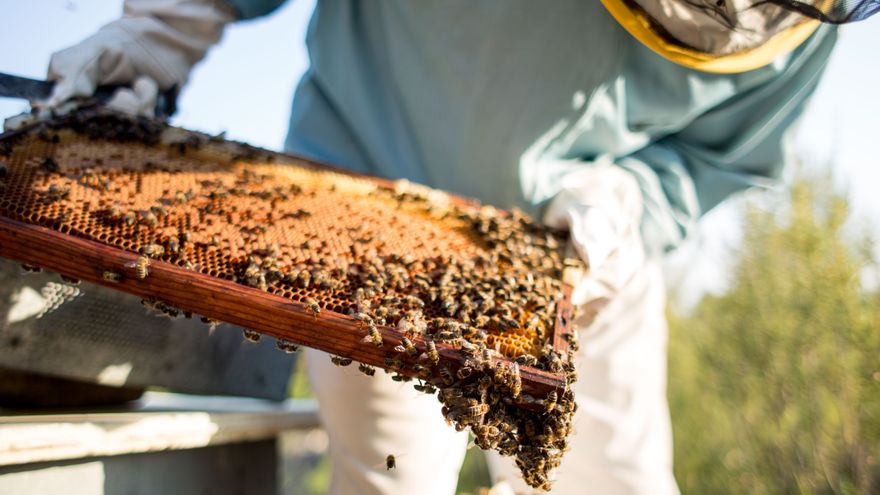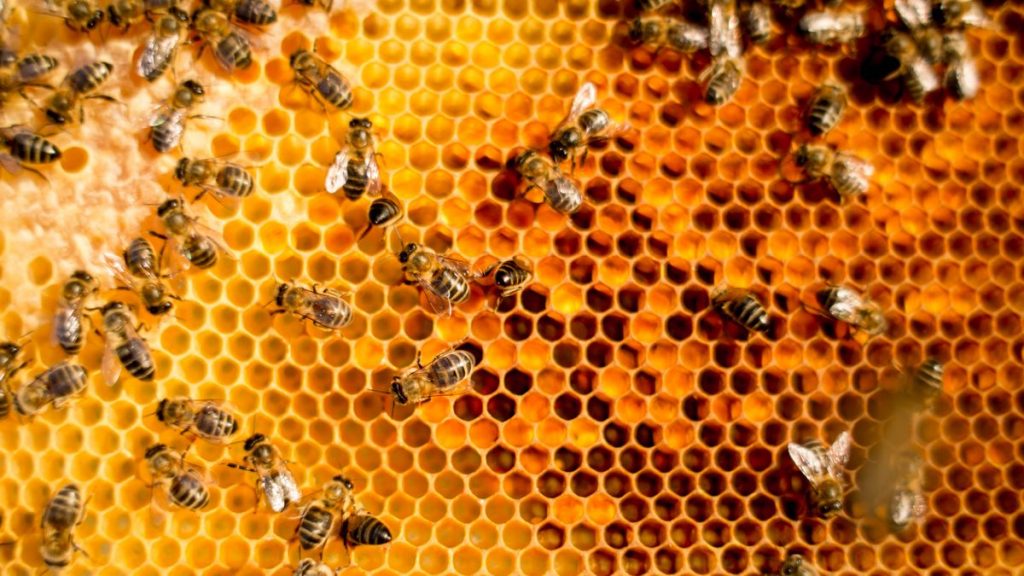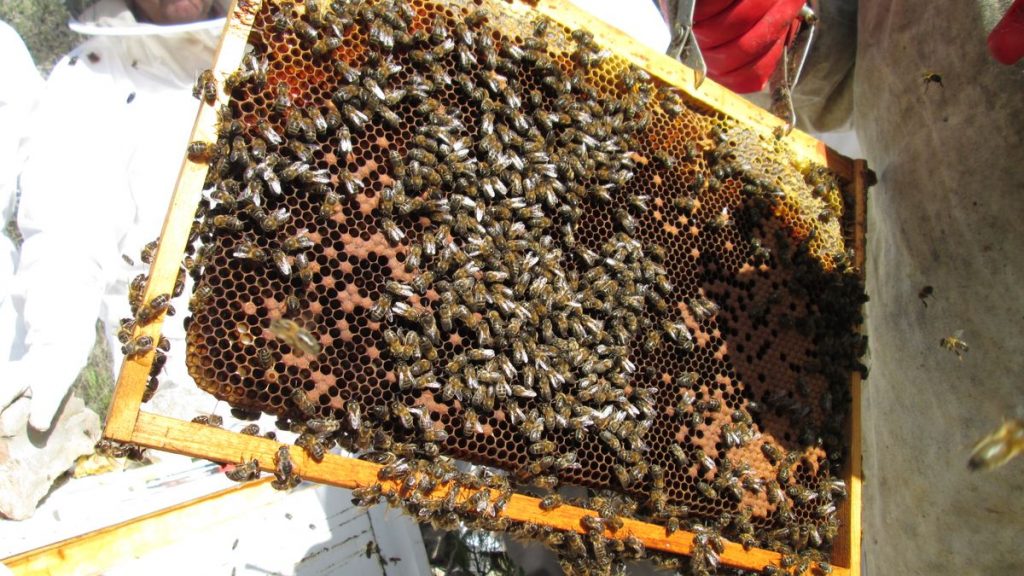Ibizan honey is unique and has been harvested on this island for hundreds of years. These are the two main conclusions reached by the ‘Justification study’ drawn up by the Associació d’Apicultors d’Eivissa in order to obtain, along with other requirements, the Protected Geographical Indication (PGI) of this nectar. The PGI protects a product, in this case Ibiza honey (if it is obtained), “against any usurpation or imitation of the registered name and guarantees the true origin of the product for its consumers”, according to the European Union, where the application will be presented: “The protection – states the EU – guarantees the consumer and all producers in the given geographical area collective rights over the product, provided that certain requirements are met”. The report, in which the president of the Ibizan beekeepers, Vicent Marí , has invested four years of research, serves to “accredit” that the Ibizan product “is different from the others for its organoleptic [what is perceived by the senses, such as taste, unctuousness] and palinological [origin of pollen] parameters,” said Marí, who hopes to present it to the EU in March.
The study stresses that the origin of Ibiza’s honey goes back to the beginnings of its civilisation: “We know that the origins and techniques of beekeeping on Ibiza have never been lost and that the use of honey and wax has always been an important part of the culture with origins beginning in the times of Ca na Costa [megalithic tomb of Formentera dated 2040 BC] until the Arab colonization [AD 902] of the islands”. The beekeeping tradition of Ibiza, “has left very interesting archaeological samples. Ancient settlers as early as the Phoenicians were already practising beekeeping on our islands, just like in other territories they had conquered”, insists the president of the beekeepers.
The ancestral caseres that have survived, scattered throughout the island’s forests, are an unmistakable trace of Ibiza’s beekeeping past and proof, due to their particular construction, that this goes back many centuries: “They have survived from possibly the Phoenicians, in the 7th century BC, to the present day, and were used until the second half of the 20th century for the production of Ibiza’s honey”. Some are still active and produce honey, but many have disappeared as the countryside has been urbanised.
“We know that the techniques of beekeeping on Ibiza have never been lost and that the use of honey and wax has always been an important part of the culture with origins beginning in the times of Ca na Costa [megalithic tomb of Formentera dated 2040 BC] until the Arab colonization [AD 902] of the islands”.
These caseres are unique: “They were built with two vertical stones, with dimensions ranging from 120 to 180 centimetres in length, by 60 to 80 centimetres in height. They had an upper slab as a crown, measuring between 120 to 180 centimeters, by 60 to 80 centimeters wide. Inside was a cylinder made of verduc, both of wild olive and juniper, covered with leaves that were compacted inside and outside with a mass of earth and lime. In the lower part there was rockery of varying granulometry for better drainage, and all this was covered with Posidonia oceanica for insulation”. The front and back of the cylinder (the fon) was covered with a sheet of wood or flat stone, and small holes were created (piquera) in the front so that the bees could access the inside. Everything was sealed with clay and lime.
Self-sufficiency
Although beekeeping “went into decline from the sixteenth century, when sugar cane and beet sugar was introduced in Europe”, that “beekeeping crisis”, however, did not affect the Pitiusas because of its isolation, which hindered the entry of sugar and forced the farmers to keep their old hives,” details Vicent Marí. “It was hardly noticed because the pagès had the need to be self-sufficient. Beekeeping would suffer later, in the 19th century, when the improvement in transport communications meant that sugar also reached the islands with a certain regularity”.
“The ancient settlers, even as far back as the Phoenicians, already practised beekeeping on our islands, as they had done in other territories they had conquered”
The supporting study provides documented references to the historical origin of Ibiza’s honey. For example, the quotes that appear in ‘De bello Maioricano o Liber maiorichinus de gestis pisanorum illustribus’, dated around the year 1125 and which narrates the Pisan-Catalan crusade to conquer Ibiza: ‘Rocky mountains encircle the whole countryside, from its soil sprout innumerable pastures and also fruits, honey in sufficient quantity, and from the springs flow streams of fresh water. Its land produces much barley and also fertile vineyards”.
According to Marí, the second oldest record of beekeeping in Ibiza dates back to 1242: “It is a lease contract for some land in the farmstead of Beniformiga, with all that is needed for its exploitation and which includes ‘les abelles que s’hi puguin trobar‘ (any bees that may be found). This is a document dated only seven years after the conquest of 1235 and from which it can be deduced that for the Arabs, “predecessors of the new settlers of the island, beekeeping was part of their agricultural activities”.
Then around 1300, the ‘Chronicle of Frare Marsili’ says that the island “melis habet satis” (has enough honey). ‘Ordinació’ also refers to it in the 13th century. It is from a series of provisions issued by the Consell regarding the construction of the market, possibly in front of the gate known as de la Mar. It is the place later known as the Plaça de Vila. The ‘Ordinació’ provides information about the farmers who sold honey from Ibiza”. Marí adds that there are also references to beeswax: “From the ‘Ordinacions’ dedicated to the candlestick trade it can be deduced that there were two basic types of candles, beeswax candles and animal fat candles, specifically sheep or goat’s. The prices of the candles were different. Wax candles [that were used in churches] could not be sold for more than ‘vuit diners la lliura entre venedures e minves e quany a VIII diners la lliura e no més‘, (“eight coins a pound between profit and loss, and VIII coins a pound and not more”.) while fat candles could not be sold for more than XIII diners la lliura. All candles had to have cotton wicks’. Wax candles were cheaper ‘because they didn’t last as long’.
There is also a judicial document from 1320 about the lawsuit between Berenguer Bru and Ramon Ballet before the Cúria Real of Ibiza for the sale of 77 cases d’abelles that Berenguer Bru had in the farmhouse of Bolatar. Ramon Ballet claimed that Berenguer had sold them to him at the price of five sous and six diners for each casera. They came to the agreement by shaking hands. But Bru backed out and Ballet reported him.
Marí also says in the report he will present to the European Union that Ibiza was on the fringes of beekeeping innovations “until the 1980s, however”, he says, “this was not the case in Mallorca and Menorca, since in 1885 the Archduke Lluís Salvador of Austria promoted and activated modern beekeeping, together with his Menorcan friend Francisco Andreu Femenías. Beekeeping traditions were preserved in the Pitiüses until well into the 20th century. The aim is to ensure that they are not lost.
An island full of beekeeping references
The toponymy has a separate chapter in this justifying study, as “the world of beekeeping has given names to a good number of people and places on the island. The motifs abella (beia) and abegot (begot), are relatively frequent”, Vicent Marí points out. For example, there are Pont d’en Begot, Puig d’en Beia, Canalet d’en Beia, sa Creu d’en Beia, Capella d’en Beia, Pujolet d’en Begot, Tanca d’en Beia, Botiga d’en Beia and Pujolet d’en Pep d’en Beia. The frequent and widespread presence of these toponyms all over the island “is clear proof of the great importance of beekeeping in Ibiza”. The presence of centenary caseres and hymenoptera has also given names to numerous geographical features such as Pujolet de ses Abelles (Benimussa), el Canalet de ses Abelles (next to Puig Redó in es Cubells), ses Abelles d’en Raio (in Puig d’en Raio, in Corona), ses Abelles Bordes (in Cala de Sant Vicent) or sa Rota de ses Abelles (Sant Miquel). Furthermore, the malnom beia “is already documented, although it is probably much earlier, in several families in 17th century Ibiza. For example, in Portmany with the surname Prats; in Buscastell, with the surname Sala; in Vedrà des Ribes with the surname Ribes, and in Vila with the surname Guasch”.
The culinary trail
The report stresses that “beekeeping is in fashion in Ibiza”, which is facilitating the generational handover: “The profile of the island beekeeper is changing. It is no longer a job exclusively for older people. There are young people who, out of curiosity or hobby, or thanks to the Associació’s training courses (up to four are given each year), are encouraged, so that a more renewed member profile has been achieved”, although the average age is still very high.
Regarding the qualities of Ibiza’s honey, Vicent Marí recalls that in 2017 a palynological study was carried out [on the pollens present]: “At the beginning of summer is when the highest quantity of multi-flower honeys are obtained, fruit of the varied spring blooms. The honeys of Eivissa are usually multifloral, originating from nectars of different blooms due to the limited extension of the crops”. It is not common to collect monofloral honeys, which come from a few botanical species. “In autumn the flowering of carob trees and heather is abundant, very characteristic of Ibiza and highly appreciated in northern Europe”, concludes Marí.
Honey was not a daily foodstuff in Ibiza, the report warns: “Its consumption was extraordinary, a delicacy to spread on bread or curd, or to accompany the fritters on the day of a very specific celebration, such as first communion, slaughter, weddings…. And also as a sweetener for such emblematic dishes in the local gastronomy as salsa de Nadal or flaó”.
In fact, the recipe for flaó that appears in the ‘Llibre del Coch’, by Mestre Robert, “one of the first printed cookery books in the world”, gives an idea of the importance that Ibiza honey: “The first edition that is preserved is from 1520 but it is known to be a copy of an older text, from around 1477. In this book we find the recipe for flaó, sweetened with Eivissa honey”, says Marí. “Y quant sien cuytes, que hauràn ja perduda la color damunt e seran acolorats un poch, lavors de calt en calt metràs-hi mel fusa o verament axarop de sucre fi ab aygua-ros. E quant quant se hagen beguda aquella mel o axarop, metràs-y damunt sucre e canyella“, is recommended in that recipe, which translates as: “And when they are cooked, which will have lost their color on top and may be painted a little, then gradually add some fresh honey or sugar syrup with rose water. When the honey or syrup is reduced, add sugar and cinnamon on top”.
A honeycomb in the crypt
In addition to the trace left by Ibizan beekeeping in documentation and archives, in the forests in the form of caseres and in names given to places around the islands, it also left its mark in the form of ceramic remains: “Among the set of ceramic materials recovered in the crypt of the Capilla del Salvador, in the year 1907, some specimens of vessels traditionally called honey pots were found”. It is an elongated vessel, with an exvasada mouth, flat bottom and no handles, decorated with schematic motifs of a very reddish gold. They were very common in the 17th and 18th centuries and were used to contain jams or honey.




